For the 2025 school year, there are 2 public middle schools serving 221 students in Paradise Unified School District. This district's average middle testing ranking is 3/10, which is in the bottom 50% of public middle schools in California.
Public Middle Schools in Paradise Unified School District have an average math proficiency score of 18% (versus the California public middle school average of 31%), and reading proficiency score of 29% (versus the 46% statewide average).
Minority enrollment is 29% of the student body (majority Hispanic), which is less than the California public middle school average of 78% (majority Hispanic).
Overview
This School District
This State (CA)
# Schools
10 Schools
3,501 Schools
# Students
1,657 Students
1,854,363 Students
# Teachers
86 Teachers
87,821 Teachers
Student : Teacher Ratio
19:1
19:1
District Rank
Paradise Unified School District, which is ranked #1253 of all 1,925 school districts in California (based off of combined math and reading proficiency testing data) for the 2021-2022 school year.
The school district's graduation rate of 90-94% has increased from 85% over five school years.
Overall District Rank
#1271 out of 1941 school districts
(Bottom 50%)
(Bottom 50%)
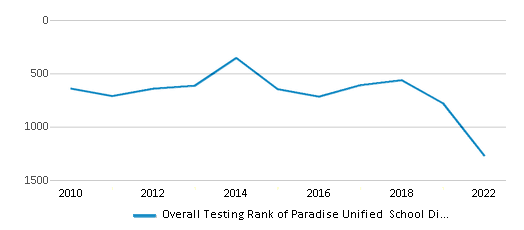
Math Test Scores (% Proficient)
23%
33%
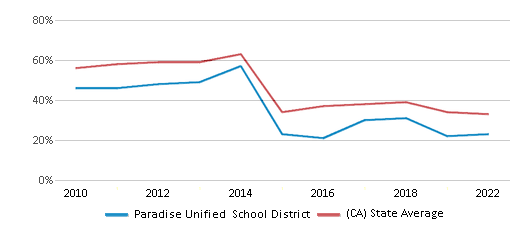
Reading/Language Arts Test Scores (% Proficient)
32%
47%
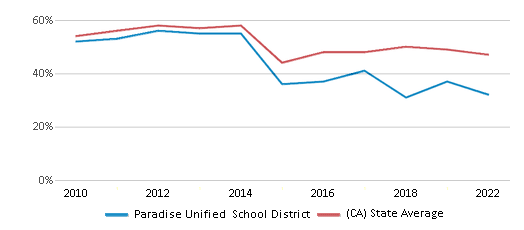
Science Test Scores (% Proficient)
25%
29%
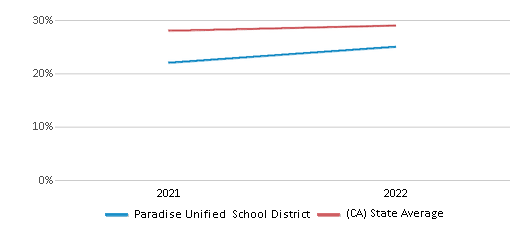
Graduation Rate
90-94%
87%

Students by Ethnicity:
Diversity Score
0.46
0.64
# American Indian Students
25 Students
9,887 Students
% American Indian Students
2%
1%
# Asian Students
21 Students
201,760 Students
% Asian Students
1%
11%
# Hispanic Students
297 Students
1,009,980 Students
% Hispanic Students
18%
55%
# Black Students
10 Students
97,908 Students
% Black Students
1%
5%
# White Students
1,179 Students
413,325 Students
% White Students
71%
22%
# Hawaiian Students
4 Students
7,600 Students
% Hawaiian Students
n/a
n/a
# Two or more races Students
114 Students
109,003 Students
% of Two or more races Students
7%
6%
Students by Grade:
# Students in PK Grade:
-
83
# Students in K Grade:
164
90,358
# Students in 1st Grade:
120
70,728
# Students in 2nd Grade:
128
73,359
# Students in 3rd Grade:
121
73,090
# Students in 4th Grade:
135
76,068
# Students in 5th Grade:
118
82,191
# Students in 6th Grade:
97
289,122
# Students in 7th Grade:
94
439,549
# Students in 8th Grade:
87
441,705
# Students in 9th Grade:
160
59,696
# Students in 10th Grade:
135
51,846
# Students in 11th Grade:
136
51,149
# Students in 12th Grade:
162
55,419
# Ungraded Students:
-
-
District Revenue and Spending
The revenue/student of $31,531 is higher than the state median of $19,974. The school district revenue/student has declined by 7% over four school years.
The school district's spending/student of $40,947 is higher than the state median of $18,396. The school district spending/student has declined by 7% over four school years.
Total Revenue
$52 MM
$116,387 MM
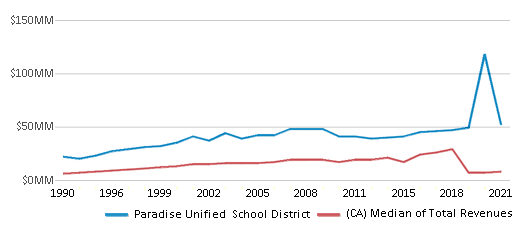
Spending
$68 MM
$107,188 MM
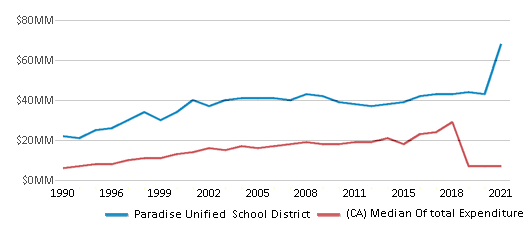
Revenue / Student
$31,531
$19,974
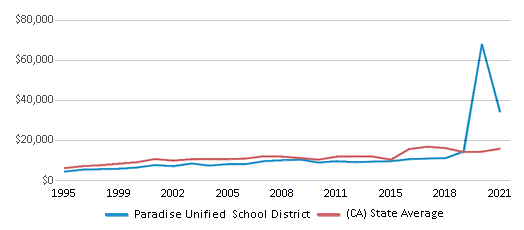
Spending / Student
$40,947
$18,396

Best Paradise Unified School District Public Middle Schools (2025)
School
(Math and Reading Proficiency)
(Math and Reading Proficiency)
Location
Grades
Students
Rank: #11.
Paradise Junior High School
(Math: 15-19% | Reading: 30-34%)
Rank:
Rank:
3/
Bottom 50%10
5657 Recreation Dr.
Paradise, CA 95969
(530) 872-6465
Paradise, CA 95969
(530) 872-6465
Grades: 7-8
| 175 students
Rank: #22.
Paradise Elearning Academy
(Math: ≤20% | Reading: 11-19%)
Rank:
Rank:
2/
Bottom 50%10
5911 Maxwell Dr.
Paradise, CA 95969
(530) 872-6425
Paradise, CA 95969
(530) 872-6425
Grades: K-12
| 46 students
Recent Articles

Year-Round Or Traditional Schedule?
Which is more appropriate for your child? A year-round attendance schedule or traditional schedule? We look at the pros and cons.

Why You Should Encourage Your Child to Join a Sports Team
Participating in team sports has a great many benefits for children, there is no doubt. In this article you will learn what those benefits are.

White Students are Now the Minority in U.S. 九游体育s
Increasing birth rates among immigrant families from Asia and Central and South America, combined with lower birth rates among white families, means that for the first time in history, public school students in the United States are majority-minority. This shift in demographics poses difficulties for schools as they work to accommodate children of varying language abilities and socio-economic backgrounds.





